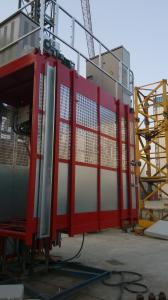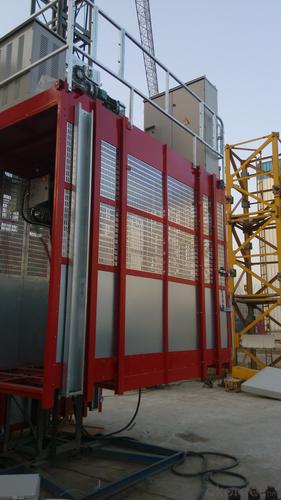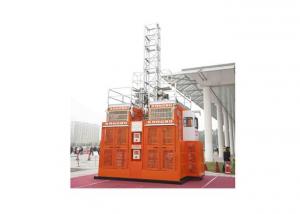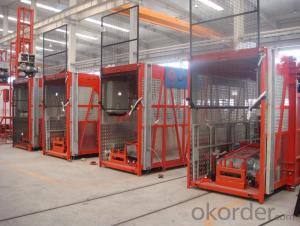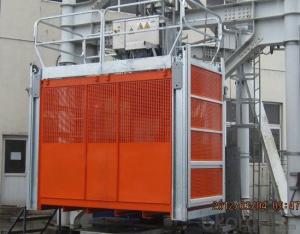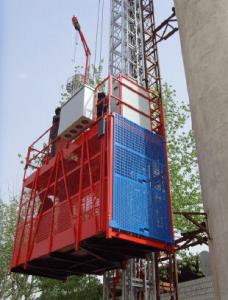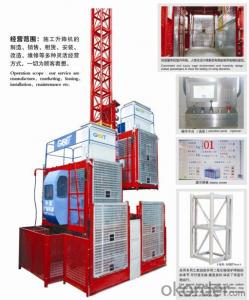Detachable Construction Hoist
OKorder Service Pledge
OKorder Financial Service
You Might Also Like
SC200 detachable construction hoist
The machine is made into five parts and connected together by bolts and nut, which is very convenient for installation in elevator shaft.
During the installation of machine in the elevator shaft, the space is very small. Due to the small entrance for elevator, the building
hoist has to be disambled into pieces, then it is very easy to move and convenient to assamble.
This machine has features as below:
1 Lifting capacity: 3000kg
2 Single cage
3 Lifting speed: 0- 60m/min, adopting Schneider inverter or Yasakawa Inverter
4 Motor power: 3x15kw
5 Mast section size: 650x650x1508mm, pipe diameter 76mm
6 Maximum lifting height: 250m,
7 Cage size: 3.2x1.5x2.5m or tailored as per clients' requirements.
the cage size can be changed to be 2.4m by removing two parts away from the machine. Also the base enclosure can be adjusted to adapt
the change of cage size.
8 Comparing with the traditional worm-gear transmission, this new driving system adopts directly connection motor & reducer, which improves
the driving efficiency, reduce the consumptions of energy.
If you have any difficulties in your construction about material lifting ,we can provide tailored design.
Construction lift with Interver:
| Characteristics | Model | Rated Loading | Lifting Speed | Motor Power | |
| Double Cabin | Low-speed | SC200/200D | 2 × 2000kg | 0-36m/min | 2 × (3 × 11kw) 2 × (2 × 13kw) 2 ×(2 × 15kw) |
| SC100/100D | 2 × 1000kg | 0-36m/min | 2 × (2 × 11kw) | ||
| Mid-speed | SC200/200Z | 2 × 2000kg | 0-60m/min | 2 × (3 × 15kw) | |
| SC100/100Z | 2 × 1000kg | 0-60m/min | 2 × (2 × 15kw) | ||
| Single Cabin | Low-speed | SC200D | 2000kg | 0-36m/min | 3 × 11kw 2× 13kw 2× 15kw |
| SC100D | 1000kg | 0-36m/min | 2 × 11kw | ||
| Mid-speed | SC200Z | 2000kg | 0-60m/min | 3× 15kw | |
| SC100Z | 1000kg | 0-60m/min | 2 × 15kw | ||
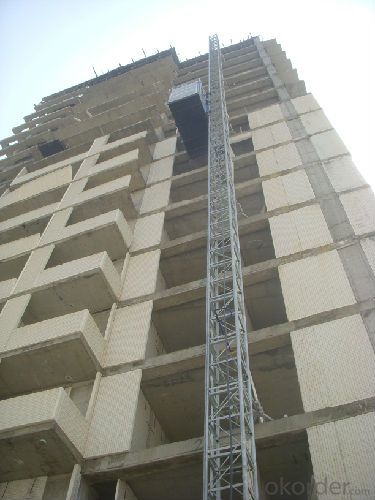
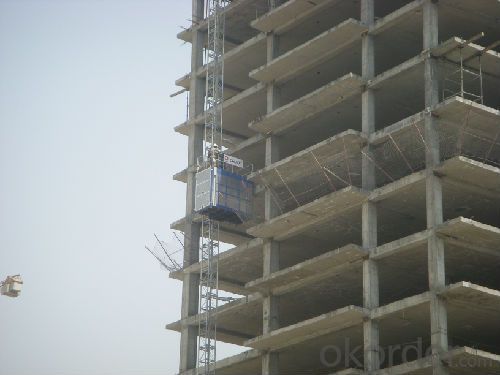
- Q: This question asks whether a building hoist can develop operational issues due to incorrect usage or lack of maintenance.
- <p>Yes, a building hoist can malfunction due to improper use or inadequate maintenance. Improper use may include overloading the hoist, using it in unsuitable conditions, or operating it without proper training. Inadequate maintenance can lead to wear and tear, lubrication issues, and component failures. Regular inspections, proper usage guidelines, and timely repairs are crucial to prevent malfunctions and ensure the safety of the hoist and its operators.</p>
- Q: This question asks if a building hoist is capable of lifting heavy objects.
- <p>Yes, a building hoist is specifically designed to lift large objects. It is a type of crane used in construction to move heavy materials and equipment to different levels of a building under construction. Building hoists can handle a significant weight, but the exact capacity depends on the specific model and its design specifications. They are essential for efficient construction processes, ensuring the safe and effective transportation of materials within the construction site.</p>
- Q: This question asks if building hoists are capable of moving large or heavy objects.
- <p>Yes, building hoists are specifically designed to move large and heavy objects vertically in construction settings. They are used to lift materials such as bricks, concrete, and steel beams to various levels of a building under construction. Building hoists are engineered to handle significant weight and are an essential tool for efficient material transport in tall structures where cranes may not be practical or safe for frequent use.</p>
- Q: This question inquires whether a building hoist can be utilized in both indoor and outdoor environments, particularly in areas with limited space.
- <p>Yes, building hoists can be used both indoors and outdoors, but their suitability depends on the specific model and design. Some hoists are specifically engineered for indoor use due to their compact size and lower weight capacity, while others are designed for outdoor use and can handle heavier loads. In limited spaces, it's crucial to select a hoist with a small footprint and high lifting capacity relative to its size. Always ensure that the hoist meets the required safety standards and is operated by trained personnel to prevent accidents in confined spaces.</p>
- Q: This question asks for the different categories of hoists used in construction.
- <p>Building hoists are essential for the construction industry and come in various types. The main types include: 1. Material Hoists, which are used for lifting building materials; 2. Personnel Hoists, designed for transporting workers; 3. Goods and Passenger Hoists, which can carry both materials and people; 4. Temporary Hoists, used during the construction phase; and 5. Permanent Hoists, installed in buildings for long-term use. Each type has specific features and safety considerations tailored to their intended use.</p>
- Q: This question asks for the safety precautions that should be taken when operating electric-hydraulic construction hoists.
- <p>Safety measures for using electric-hydraulic building hoists include regular maintenance and inspection to ensure all components are in good working order. Operators must be trained and certified, following all safety protocols. Never exceed the hoist's load capacity. Ensure that safety hooks and chains are in place and secure. Keep the hoist area clear of debris and unauthorized personnel. Use proper lifting techniques and avoid sudden starts or stops. Always inspect the load before lifting to ensure it is stable and secure. Emergency stop switches should be easily accessible. Ensure that all safety guards are in place and functioning properly. Adhere to all local regulations and manufacturer's guidelines.</p>
- Q: Elevator installation approach, need to give the total package (inspect) what data, come a master to answer the detail point
- Supplement: Component members: project manager, safety personnel, inspectors, field director, technical director, foreman, elevator operation (mechanical, electrical installation and maintenance) welders, electricians, scaffolder, etc. The subcontract unit project manager shall have a certificate of construction, and special work shall be given the special work certificate. If the special work certificate is outside the province and province, the construction committee of the construction site should be put on the record.
- Q: When building tall buildings, the machine that USES to lift concrete to wait for tall building
- The concrete pump, which can be raised in a certain radius, is the tower crane.
- Q: This question asks about the various mechanisms that enable lifting in building hoists, which are essential for construction projects.
- <p>Building hoists utilize several types of lifting mechanisms to efficiently move materials and personnel. The most common types include: 1. Geared Hoists, which use a system of gears to lift and lower loads. 2. Electric Chain Hoists, powered by electric motors and are suitable for heavier loads. 3. Air Hoists, which use compressed air to generate lifting force and are ideal for environments where electricity is a hazard. 4. Manual Chain Hoists, operated by hand and best for lighter loads. 5. Electric Wire Rope Hoists, which offer high lifting capacities and are controlled by electric motors. 6. Pneumatic Hoists, similar to air hoists but use pneumatic power for lifting. Each type has specific applications and safety considerations, making them suitable for different construction needs.</p>
- Q: This question asks about the typical issues encountered with construction hoists and seeks solutions to address these problems.
- <p>Common problems with building hoists include mechanical failures, electrical issues, safety hazards, and improper maintenance. Mechanical failures can be fixed by regular inspection and timely replacement of worn-out parts. Electrical issues are often resolved by checking wiring and connections, and using surge protectors. Safety hazards can be mitigated by ensuring all safety features are operational and by providing proper training to operators. Improper maintenance can be addressed by establishing a routine maintenance schedule and ensuring that all personnel follow safety protocols. Regular inspections, prompt repairs, and operator training are key to maintaining the functionality and safety of building hoists.</p>
Send your message to us
Detachable Construction Hoist
OKorder Service Pledge
OKorder Financial Service
Similar products
Hot products
Hot Searches
Related keywords
